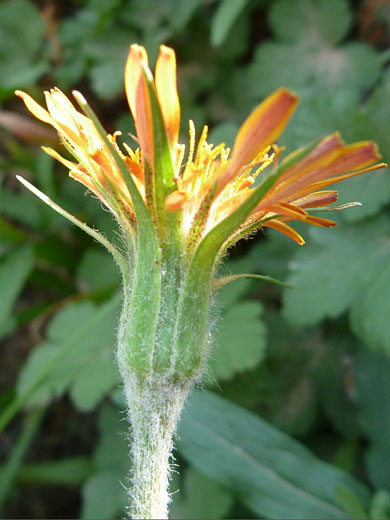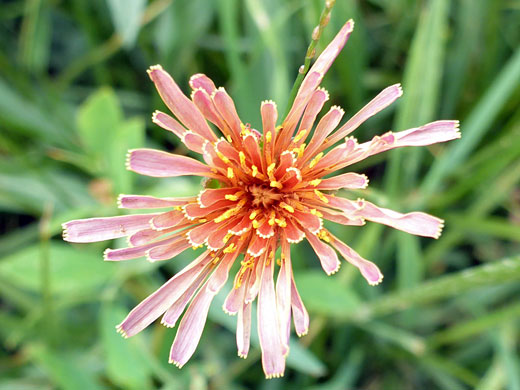Common names:
Orange agoseris, mountain dandelion
Family:
Scientific name:
Agoseris aurantiaca
Main flower color:
Range:
Some areas of all the Western states between the Rocky Mountains and the Pacific Ocean
Height:
Up to 24 inches
Habitat:
Meadows, woodland clearings; generally mountainous areas, up to 11,500 feet
Leaves:
Up to 12 inches long, very narrow, sometimes with a few teeth or small lobes
Season:
June to August
The long, thin, linear or lance-shaped leaves of agoseris aurantiaca grow only around the base; the unbranched stems are leafless, topped by a single flower head of burnt orange ray petals, each with a few tiny teeth at the tips. Petals are smaller towards the center, where they are surrounded by long woolly hairs. Also at the center are quite long orange stamens, split at the ends. The edges of the petals may turn yellow when mature, while on rare occasions the whole flower may be colored yellow, pink, or white.
Stems have a covering of hairs, and like the common dandelion which the plant resembles, contain milky sap. The phyllaries taper to a narrow tip, and extend outwards a similar distance to the petals. They usually have a covering of straggly white hairs, and may have a purplish band down the middle.
There are two varieties: for the widespread var aurantiaca the phyllaries are lanceolate in shape and have edge hairs along the lower half, while for var purpurea (most common in the Colorado Plateau and the Rocky Mountains) the phyllaries are wider and more ovate in shape, and edge hairs are concentrated along the upper half.
Stems have a covering of hairs, and like the common dandelion which the plant resembles, contain milky sap. The phyllaries taper to a narrow tip, and extend outwards a similar distance to the petals. They usually have a covering of straggly white hairs, and may have a purplish band down the middle.
There are two varieties: for the widespread var aurantiaca the phyllaries are lanceolate in shape and have edge hairs along the lower half, while for var purpurea (most common in the Colorado Plateau and the Rocky Mountains) the phyllaries are wider and more ovate in shape, and edge hairs are concentrated along the upper half.
All Contents © Copyright The American Southwest | Comments and Questions | Contribute | Site Map






